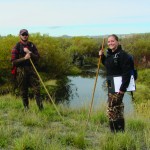Capri Gillam is an Environmental Engineering Master’s student at Montana Tech in Butte. She earned her Bachelor’s degree in 2009 from Montana State University in biological sciences, and has worked around the globe doing ecology studies as well as wildlife and ecosystem sustainability. Capri is an avid outdoorsman and enjoys adventures, hiking, fishing, and backcountry camping.
Butte has a long and famous history as a mining town, and has been dubbed “The Richest Hill on Earth.” According to the Mining History Association, the earliest discoveries of gold in the area occurred in 1864. Since this time, a matrix of over 10,000 miles of tunnels have been carved under the city. Silver Bow Creek and its tributaries were used for smelting, mining, and waste removal from both the city and industry. Only more recently are the historical impacts of mining being addressed.
In 2008, the Atlantic Richfield Company (ARCO), now known as BP-ARCO, agreed to pay the state of Montana a settlement of $169 million for mining damages along the Clark Fork River. As part of these funds, the Natural Resources Damage Program (NRDP) set aside a budget to “improve fishery and wildlife habitat and related recreational opportunities in the Upper Clark Fork basin.”
This past summer, the Montana Tech Environmental Engineering department received funding to complete a riparian assessment along Blacktail Creek. This Clark Fork tributary feeds into Silver Bow Creek and is a part of the larger restoration project funded by the state.
The goal of the project is to develop an assessment of riparian corridor health based on vegetation diversity, fish habitat, and total erosion. A collaborative team that includes the National Resources Damage Program (NRDP) and the Water Resource Council (WRC) is working together to pinpoint source problems along the creek and make recommendations for riparian habitat improvement.
This project is designed to prioritize stream reaches based on a riparian health score, and to propose projects that will best improve the overall health of the creek. Ultimately, by improving stream habitat and riparian health in the upper Clark Fork tributaries, native cutthroat trout can regain access from headwater streams into the Upper Clark Fork where they can repopulate their native waters.
Please volunteer to help with this year’s clean up.


